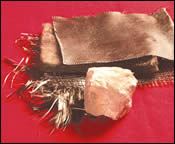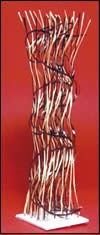Lava-Based Fibers Reinforce Composites
Reinforcing fibers spun from basalt lava rock were one of the more unusual developments exhibited at the JEC Composites Show in Paris in April.
Reinforcing fibers spun from basalt lava rock were one of the more unusual developments exhibited at the JEC Composites Show in Paris in April. Other news in reinforcements at the show included high-tensile polypropylene fibers and new carbon fibers and 3D fabrics.
Fibers from lava
Development of novel continuous mineral fibers has been a Russian specialty since the Cold War arms race and continues today in new composite materials. Most promising for composites are basalt fibers, which were presented at the JEC show by two Russian companies—Kamenny Vek and Sudaglass Fiber Technology Inc. (U.S. office in Houston)—as well as a Belgian firm named Basaltex.
Basalt is cooled lava, a dark-gray rock with a melting point of 2600 F. In fiber form it outperforms nylon and carbon fibers in high-temperature and cryogenic environments and surpasses E-glass in mechanical properties. Basalt has better tensile strength (682 kpsi vs. 500 kpsi for glass), compressive strength (550 kpsi vs. 440 kpsi), and tensile modulus (12.9 Mpsi vs 11.2 Mpsi). Basalt also beats glass in acid and alkali resistance. It damps vibration, so it has sound-insulating properties. Yet basalt is only 5% heavier, with a density of 2.75 g/cc vs. 2.60 for glass.
Sudaglass says basalt fiber prices are comparable to high-quality E-glass at about $1.50/lb. Customers say basalt actually runs more like $3/lb, but that is still dramatically less than S-2 glass ($7 to $9/lb) or carbon fiber ($13 to $18/lb).
Sudaglass produces continuous basalt filament in Russia, where it has 3 million lb/yr capacity. Sudaglass announced plans to add another 8 million lb/yr of capacity through a joint venture in Ukraine and a U.S. plant at a still-undetermined location. The company offers filaments of 9 to 22 microns, yarns and rovings from 320 to 4800 tex, plus chopped fibers and woven and nonwoven fabrics 1 meter wide.
Kamenny Vek is a new company with a pilot plant for basalt smelting and producing developmental quantities of basalt roving and chopped fiber in filament diameters of 10 to 17 microns. It also offers fabrics made by custom weavers. Kamenny Vek is building a 10-million-lb/yr basalt fiber plant in Russia that is to start up in September.
Basaltex buys its basalt fiber under an exclusive agreement from TZI, a Ukrainian producer. Basaltex then weaves fabrics up to 2 meters wide and also offers rovings and chopped strands. Technical Fibre Products, a U.K. company with a U.S. sales office, has tested epoxy sheet containing basalt fibers and intumescent nonwoven fiber mats as a fireproofing material to meet fire codes in concrete bridge and marine applications.
Glasforms Inc., a pultruder in Birmingham, Ala., recently purchased more than a ton of basalt roving for product testing, says president Peter Pfaff.
Euro Plants SrL in Italy has impregnated basalt fibers with powdered thermoplastics to produce a composite molding material. These Key-Tex fibers come with PP, PE, nylon (6, 66, 11, and 12), PET, TPU, and PPS.
All-PP composite
Lankhorst Indutech bv in the Netherlands, a long-time specialist in rope making, has patented an oriented, flat polypropylene filament that is coextruded in three layers with a homopolymer core and copolymer skins (ABA structure). Lankhorst says the high-strength fiber, called PURE, is at least five times stiffer than conventional monolayer PP filament. Because the copolymer outside melts at a lower temperature (266 F) than the homopolymer core (356 F), PURE allows an all-PP woven composite to be formed directly into parts by using heat and pressure to fuse the outer layers without losing the orientation in the core. PURE could also be used to reinforce molded PP parts. Either way, the entire composite is easily recyclable. PURE comes as tape, fabric, or consolidated sheets with a flexural modulus of 1.16 Mpsi.
DTC Delft Thermoplastic Composites of Lelystad, the Netherlands, was at JEC showing a helmet that is the first commercial part molded entirely of Lankhorst’s PURE woven fiber.
Also in thermoplastic composites, Saint-Gobain Vetrotex introduced a developmental form of its Twintex material (co-woven glass and PP) that combines glass and nylon fibers. New Twintex Polyamid contains about 65% glass and is expected to be commercial in two years. Samples are available now. It targets automotive parts like front-end carriers because it has better long-term heat aging than long-glass PP.
Carbon fibers, 3D weaves
NGF Nippon Graphite Fiber Corp. of Japan (represented here by Thomas Wong) showed a new pitch-based carbon fiber, CN80-A2S, with a very high tensile modulus of 113 Mpsi and tensile strength of 500 kpsi. NGF also showed a new carbon fiber, XN-100C, with high thermal conductivity >900 W/mdK—more than twice the conductivity of copper and four times that of aluminum. XN-100C also comes chopped in lengths of 150 microns to 25 mm.
Oxeon AB, a year-old Swedish R&D company, introduced a woven structure made of flat carbon fiber tapes 20 to 50 mm wide. Called Oxeon-TeXtreme, these fabrics reportedly offer more strength/weight and a smoother surface than woven roving. Tapes are interwoven at 90° angles and will soon be woven at 45° too. Fabrics are stabilized with polyester fibers and sized for epoxy or other resins.
Biteam AB, a small Swedish R&D firm, has also developed a 3D weaving technique called dual-directional spatial weaving. It interlaces fibers at 45° and 90° angles and even in spirals. Spatial yarns provide reinforcement in multiple loading directions. They allow shell, tubular, and solid preforms to be woven directly and can use virtually all fibers, Biteam says.
Related Content
Research Suggests Path From Waste Plastics to High Value Composites
Flash joule heating could enable upcycling of waste plastic to carbon nanomaterials.
Read MoreRead Next
Processor Turns to AI to Help Keep Machines Humming
At captive processor McConkey, a new generation of artificial intelligence models, highlighted by ChatGPT, is helping it wade through the shortage of skilled labor and keep its production lines churning out good parts.
Read MoreTroubleshooting Screw and Barrel Wear in Extrusion
Extruder screws and barrels will wear over time. If you are seeing a reduction in specific rate and higher discharge temperatures, wear is the likely culprit.
Read MoreWhy (and What) You Need to Dry
Other than polyolefins, almost every other polymer exhibits some level of polarity and therefore can absorb a certain amount of moisture from the atmosphere. Here’s a look at some of these materials, and what needs to be done to dry them.
Read More
















.png;maxWidth=300;quality=90)







